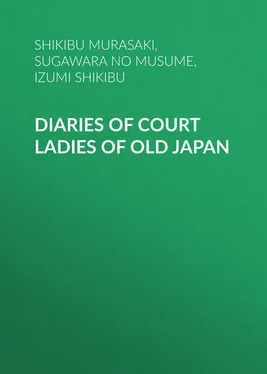Shikibu Murasaki - Diaries of Court Ladies of Old Japan
Здесь есть возможность читать онлайн «Shikibu Murasaki - Diaries of Court Ladies of Old Japan» — ознакомительный отрывок электронной книги совершенно бесплатно, а после прочтения отрывка купить полную версию. В некоторых случаях можно слушать аудио, скачать через торрент в формате fb2 и присутствует краткое содержание. Жанр: История, foreign_edu, на английском языке. Описание произведения, (предисловие) а так же отзывы посетителей доступны на портале библиотеки ЛибКат.
- Название:Diaries of Court Ladies of Old Japan
- Автор:
- Жанр:
- Год:неизвестен
- ISBN:нет данных
- Рейтинг книги:4 / 5. Голосов: 1
-
Избранное:Добавить в избранное
- Отзывы:
-
Ваша оценка:
- 80
- 1
- 2
- 3
- 4
- 5
Diaries of Court Ladies of Old Japan: краткое содержание, описание и аннотация
Предлагаем к чтению аннотацию, описание, краткое содержание или предисловие (зависит от того, что написал сам автор книги «Diaries of Court Ladies of Old Japan»). Если вы не нашли необходимую информацию о книге — напишите в комментариях, мы постараемся отыскать её.
Diaries of Court Ladies of Old Japan — читать онлайн ознакомительный отрывок
Ниже представлен текст книги, разбитый по страницам. Система сохранения места последней прочитанной страницы, позволяет с удобством читать онлайн бесплатно книгу «Diaries of Court Ladies of Old Japan», без необходимости каждый раз заново искать на чём Вы остановились. Поставьте закладку, и сможете в любой момент перейти на страницу, на которой закончили чтение.
Интервал:
Закладка:
That passage needs no comment; it is completely illuminating. It is a paraphrase of the whole era.
Kiōto was a little city, long one way by some seventeen thousand odd feet, or about three and a third miles, wide the other by fifteen thousand, or approximately another three miles, and it is doubtful if the space within the city wall was ever entirely covered by houses. The Palace was built in the so-called Azumaya style, a form of architecture which was also followed in noblemen's houses. The roof, or rather roofs, for there were many buildings, was covered with bark, and, inside, the divisions into rooms were made by different sorts of moving screens. At the period of the Diaries, the reigning Mikado, Ichijo, had two wives: Sadako, the first queen, was the daughter of a previous prime minister, Michitaka, a Fujiwara, of course; the other, Akiko, daughter of Michinaga, the prime minister of the Diaries and a younger brother of Michitaka, was second queen or Chūgū. These queens each occupied a separate house in the Palace. Kokiden was the name of Queen Sadako's house; Fujitsubu the name of Queen Akiko's. The rivalry between these ladies was naturally great, and extended even to their entourage . Each strove to surround herself with ladies who were not only beautiful, but learned. The bright star of Queen Sadako's court was Sei-Shōnagon, the author of a remarkable book, the "Makura no Sōshi" or "Pillow Sketches," while Murasaki Shikibu held the same exalted position in Queen Akiko's.
We are to imagine a court founded upon the Chinese model, but not nearly so elaborate. A brilliant assemblage of persons all playing about a restricted but very bright centre. From it, the high officials went out to be governors of distant provinces, and the lesser ones followed them to minor posts, but in spite of the distinction of such positions, distance and the inconvenience of travelling made the going a sort of laurelled banishment. These gentlemen left Kiōto with regret and returned with satisfaction. But the going, and the years of residence away, was one of the commonplaces of social life. Fujiwara though one might be, one often had to wait and scheme for an office, and the Diaries contain more than one reference to such waiting and the bitter disappointment when the office was not up to expectation.
These functionaries travelled with a large train of soldiers and servants, but, with the best will in the world, these last could not make the journeys other than tedious and uncomfortable. Still there were alleviations, because of the very taste of which I have spoken. The scenery was often beautiful, and whether the traveller were the Governor himself or his daughter, he noticed and delighted in it. The "Sarashina Diary" is full of this appreciation of nature. We are told of "a very beautiful beach with long-drawn white waves," of a torrent whose water was "white as if thickened with rice flour." We need only think of the prints with which we are familiar to be convinced of the accuracy of this picture: "The waves of the outer sea were very high, and we could see them through the pine-trees which grew scattered over the sandy point which stretched between us and the sea. They seemed to strike across the ends of the pine branches and shone like jewels." The diarist goes on to remark that "it was an interesting sight," which we can very well believe, since certainly she makes us long to see it.
These journeys were mostly made on horseback, but there were other methods of progression, which, however, were probably not always feasible for long distances. The nobles used various kinds of carriages drawn by one bullock, and there were also palanquins carried by bearers.
It was not only the officials who made journeys, all the world made them to temples and shrines for the good of their souls. There are religious yearnings in all the Diaries, and many Mikados and gentlemen entered the priesthood, Michinaga among them. Sutra recitation and incantation were ceaselessly performed at Court. We can gain some idea of the almost fanatical hold which Buddhism had over the educated mind by the fact that the Fujiwara family built such great temples as Gokurakuji, Hosohoji, Hokoin, Jomyoji, Muryoju-in, etc. It is recorded that Mikado Shirakawa, at a date somewhat subsequent to the Diaries, made pilgrimages four times to Kumano, and during his visits there "worshipped 5470 painted Buddhas, 127 carved Buddhas sixteen feet high, 3150 Buddhas life-sized, 2930 carved Buddhas shorter than three feet, 21 pagodas, 446,630 miniature pagodas." A busy man truly, but the record does not mention what became of the affairs of state meanwhile. That this worship was by no means lip-devotion merely, any reader of the "Sarashina Diary" can see; that it was mixed with much superstition and a profound belief in dreams is also abundantly evident. But let us, for a moment, recollect the time. It will place the marvel of this old, careful civilization before us as nothing else can.
To be sure, Greece and Rome had been, but they had passed away, or at least their greatness had, gone and apparently left no trace. While these Japanese ladies were writing, Europe was in the full blackness of her darkest ages. Germany was founding the "Holy Roman Empire of the German Nation," characteristically founding it with the mailed fist; Moorish civilization was at its height in Spain; Robert Capet was king of poor famine-scourged France; Ethelred the Unready was ruling in England and doing his best to keep off the Danes by payment and massacre. Later, while the "Sarashina Diary" was being written, King Canute was sitting in his armchair and giving orders to the sea. Curious, curious world! So far apart from the one of the Diaries. And to think that even five hundred years later Columbus was sending letters into the interior of Cuba, addressed to the Emperor of Japan!
These Diaries show us a world extraordinarily like our own, if very unlike in more than one important particular. The noblemen and women of Mikado Ichijo's Court were poets and writers of genius, their taste as a whole has never been surpassed by any people at any time, but their scientific knowledge was elementary in the extreme. Diseases and conflagrations were frequent. In a space of fifty-one years, the Royal Palace burnt down eleven times. During the same period, there were four great pestilences, a terrible drought, and an earthquake. Robbers infested many parts of the country, and were a constant fear to travellers and pilgrims. Childbirth was very dangerous. The picture of the birth of a child to Queen Akiko, with which Murasaki Shikibu's Diary begins, shows us all its bitter horror. From page to page we share the writer's suspense, and with our greater knowledge, it is with a sense of wonder that we watch the queen's return to health.
Читать дальшеИнтервал:
Закладка:
Похожие книги на «Diaries of Court Ladies of Old Japan»
Представляем Вашему вниманию похожие книги на «Diaries of Court Ladies of Old Japan» списком для выбора. Мы отобрали схожую по названию и смыслу литературу в надежде предоставить читателям больше вариантов отыскать новые, интересные, ещё непрочитанные произведения.
Обсуждение, отзывы о книге «Diaries of Court Ladies of Old Japan» и просто собственные мнения читателей. Оставьте ваши комментарии, напишите, что Вы думаете о произведении, его смысле или главных героях. Укажите что конкретно понравилось, а что нет, и почему Вы так считаете.












